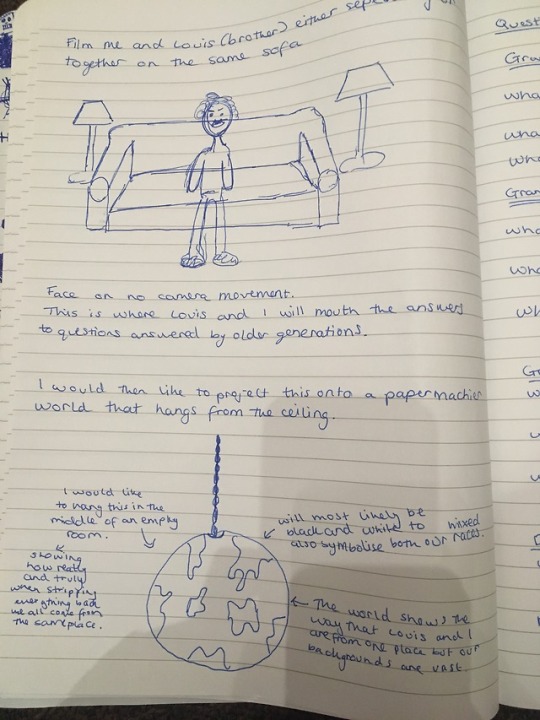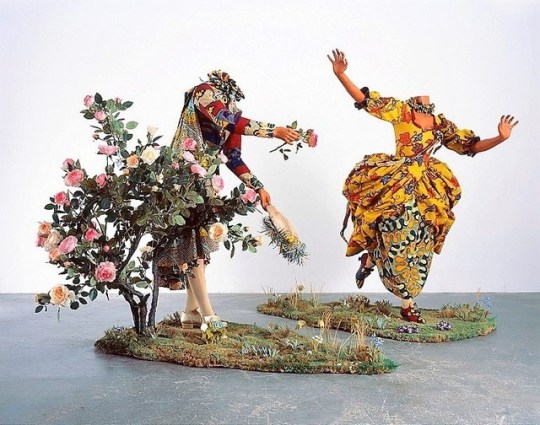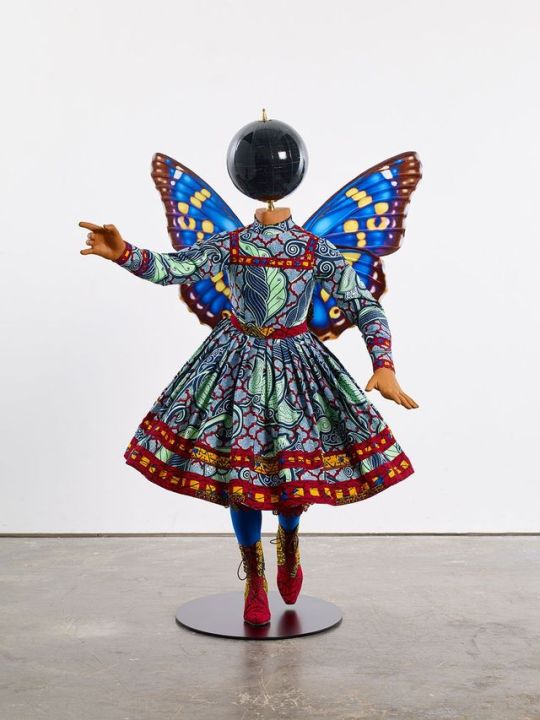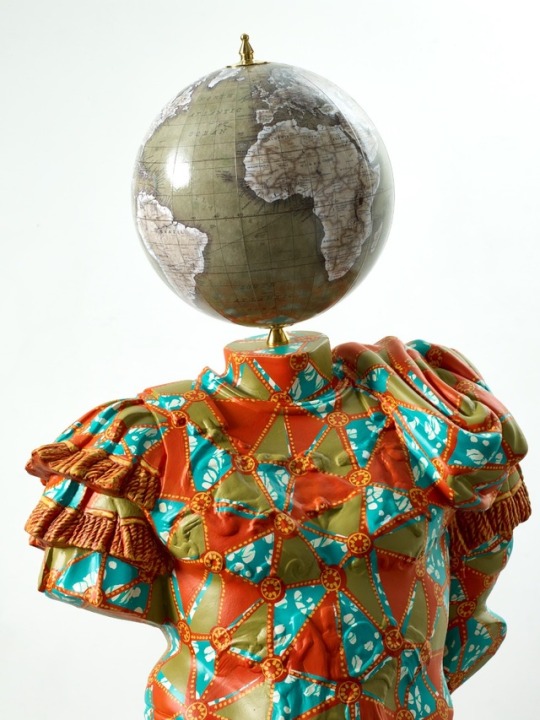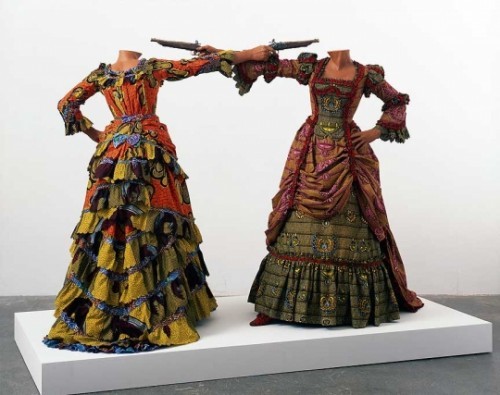Don't wanna be here? Send us removal request.
Text
Statement
Key ideas/ concept
The main idea behind this piece was to create an installation that showed where I myself come from, whether that be culturally, religiously or even through personality. Looking at the idea that I am the product of the previous generations before me. In the piece I do not speak, but the generations before me tell their stories of growing up. I mouth the the things that the generations before me say to indicate that these voices are what make me up to be me. Being someone of mixed races, a topic that is talked about in the piece, the film is projected onto a black and white sculpture of the world to symbolise that I am both black and white and made up of multiple different countries from around the world. The piece will hopefully provoke an audience to think about or ask questions about where they are from due to the titles seen at the beginning and the end of the piece. “Who am I?”and “Who are you?”.
The piece itself I see as an installation that would not normally be shown on its own, but as a part of an exhibition on identity as I feel it may make more sense as a piece alongside other pieces about identity.
Research
For my research I decided to look into artists that are interested in cultural identity. One of these artists was Yinka Shonibare an African artist that makes sculptures and clothing out of traditionally seen African patterns, however when looking into the past of these patterns they are found to be originally Indonesian and brought to Africa by the dutch and his sculptures often show some sort of colonialist element. Shonibare’s work alerts people to the fact that we all have roots in different places. No one is 100% of one culture. This was interesting to me as it introduced the idea that things like racism and xenophobia are man made thought processes that people may think twice on if they looked into their generational past.
Another artist I looked at was Cathy Lu an Asian-American artist who looks into the ideas of exploring her cultural identity through the use of art,being a Chinese girl that was born and raised in San Francisco. Even though she can’t speak the language she tries to connect with her family culture by fusing the two cultures she has been nourished in, in her paintings and sculptures. This resonated with me as having parents with very different cultural backgrounds I feel I was immersed in two very different cultures from a young age.
Finally for visual purposes I looked at Gillian Wearing’s “2 into 1” (1997) as it gave me inspiration for a way in which I could collate all the information from my family members and directly relate them to me.
Cultural context
Shonibare said “ What you see is not necessarily what you get” and I think this sums up what the cultural context of this piece is. For people to understand that we are all made up of so many cultures, that prejudice of cultures and race make absolutely no sense. Another idea behind the piece is to make people question who they are and where they come from.
Your process
I started by interviewing my grandparents and my parents separately over the phone asking them specific questions about their childhood and growing up. After doing this I edited them down and strung the different family members together into one audio track that I could then mouth to in filming. I then decided to transcribe what my family members had said as I felt this would make my job easier when it came to the filming. In filming I used a VHS camera to give a sort of “home movie” visual to it, as I wanted the piece to feel nostalgic and comfortable.In filming I placed the transcription under the camera on autocue, played the audio out loud and tried my best to mouth to it without looking down at the autocue screen too much. In editing, I converted the tape to digital format in premiere pro and matched the best of my mouthing takes to the audio track previously made.
For the globe sculpture, I bought a large helium balloon, paper machiered it and painted it black and white. I then punched two holes in either side to allow me to tie rope through these holes so that I could hang the globe up for projection.
Analysis/ evaluation of the final work
Overall I am happy with the piece I feel that it addresses the issues I set out to address when I started planning for it and I have achieved that homemade feel I was going for. I am concerned however that the questions asked in the piece do not come across in the video and this is why I feel the piece would work better as an installation shown in a wider exhibition about identity, as it would be made clear throughout the exhibition who I was and where I come from. However I decided to add the questions, “who am I?” and “who are you?” towards the end of creating this piece and I feel this brings the piece together as an audience should become aware that the people talking are something to do with me. The question “who are you?” at the end allows them to relate to the piece on a personal level.
0 notes
Text
Transcription
I decided to transcribe the 10 minutes of audio that I edited for the piece. This meant that I didn’t need to memorize what my family members had said and allowed me to have an auto cue placed under the camera for filming for any parts that I might forget as I went along. Transcribing this meant adding in all the stutters and accents so that i could mouth the audio as accurately as possible.
Dad: I am Carribean British.
GP: White caucasian
Mum:I would say white british
G: Barbadian
GM: Caucasian white
G:It wa a happy childhood yoooou you lots of time to play
GM:I was 5 when the war ended. It was nice in brighton because of the seaside,you couldn’t go on the beach because it was covered in barbed wire,because of the unexploded bombs that they thought might be there.So we didn’t go on the beach probably till i was 8 or 9.I had a nanny that looked after me, she died when I was about 8.They never said that she was leaving or anything I mean it had been like my mother. I didn’t know my mother really. Coz up to 5,the age of 5,1945. She was in London,sort of working and then sh-she was around more after the war ended,but I still Nanny stayed she was really really nice. And then one day Mum said she was going to..Nanny was going home to visit her family and she just never came back. And uh she said to me”Oh nanny’s died and um I’ll be looking after you from now on” and that was a very vivid memory she was the way she said it was like “I don’t want to but I will be, I’ll be looking after you from now on”
GP:We didn’t move uh to brighton until I was 12. It was a good place to gorw up, really.because you had the uh sea by that time the beaches were available and uh I had a a tennis cliub I belonged to
G: Ya’ll got a differnt name for it but...Richard... you not busy are you. Jus a quick question, you know when ya’ll was growing up and you had these little kinda like kinda iron shape things where you trow up in de air you pick up you throw up in the air and pick up the udder. Wa ya call it.JACKS. Well its similar to jacks in Barbados it was uh little pebbles coz we didn’t have jacks at that time.
Mum: I never felt threatened I have to say um I probably grew up in quite a safe environment but looking back it probably would’ve been better to be a little more multicultural and with a more open view it was quite a privileged childhood where I didnt really know much about what else was goin on. It being the 80s there were areas tha-of society that were not so easy to live in but I but my childhood and what I experienced was really pretty easy.
Dad: It was an interesting experience. I grew at a time when there was a lot of adversity to people of colour being here so it was I was first generation born here or 1st..the second generation Afro Carribean sooo I grew in a time where the national front was a really strong party which resulted in a lot of hatred towards black people in general but that manifested in schools and in the way that people generally would perceive you or or deal with you on the streets. The older white generation would look at you as a little black thief.You could very easily see that thats the way that they were looking at you and dealing with you. It was something you felt as opposed to something that you saw. But you were also walking around people that were skinheads and were very openly racist. So you would walk past a street and literally people would spit at you uh or call you a black so and so at will. It was very difficult but it armed you for latter life because you were aware of how people could be.
G:In the west indies as a whole. The elders are very strict with the youngsters you’ve got to be respectful ya kna you couldnt stand in fron of your granmadda or you know and thing and swear or anything like that coz they’ll beat you you’ll get a couple slaps a couple you know.
GPA: I dont remember anything really about any sort of religious practice or even discussion of religion. I think the thing which made it jewish was that one errr cared whether people were jewish or not and most of the errrrf riends my parents had they were they were jewish there were jewish people lived in the road were friendly with them weren’t particulary friendly with anybody else in the road. So you know I have to question now is errr why was the family particularly friendly with other jewish families.When we didnt practice judaism at all and I think that is an interesting question because you know it raises the whole query really of what makes you feel jewish. It was secular and yet it was distinctively jewish.
GMA: They weren’t religious at all my parents.In fact I would say the dominating idea my father had was to assimilate into society because of the terrible things that had happened to the jews in the war. He didn’t want to advertise the fact that we were jewish, and he played bridge a lot at a club and because it was brighton there were a lot of jewish people but I think mmmost of his friends weren’t jewish, but nevertheless in the family there was an i a sort of sort of separation in their minds about people who were jewish and who weren’t. There’s no doubt about it.You know they still thought like jews but they didn’t practice in any way being jews. Except my grandma who used to go to synagogue on sort of important days and fasted once a year on passover. And they used to make a terrible business about the fasting which was ridiculous really. All it meant was missing two meals.(laughs) you’d think it was the end of the world and then they have a big feast afterwards with cold fried fish and chicken soup.
Mum:The areas growing up that are sorsort of common to there being a jewish household is mealtimes and food. Food played a massive part of our lives sooo you know mum was always into cooking and nurturing and that sort of classic jewish mother have another peice of cake have another biscuit. It’s like my friends as kids when the came round they always used to say “ohhh Ilove coming to your mums because she you’d walk in the door from school and she’d say right what can i get you darling. Can I get you hot chocolate?”. People say that Jewish families when they eat they all talk at once and I think that’s probably true. Nobody listens to eachother everybody talks over each other. Bing jewish wasn’t an aspect that came into things except when mum and dad would occasionally say something in errr yiddish,like a wor-they don’t speak yiddish but they’d say some funny word from their childhood.I dont think I even knew I was jewish til I was a teenager.
Dad:My mother became a a a christian as in devout christian around the age of 45 urm so up until then we’d lived in a fairly a a very structured environment but not with th-the kind of biblical presence that manifested urm as we got older. And actually again that was enlightening because you saw someone change so much as in as in my mother you saw her take on take on a belief and that belief really started to empower her. So it was enlightening and valuable to see the power of what belief manifested in in um someone.
Mum: It was very comfortable but with hindsight uh uh I think it a bit of a blinkered view of what life is like if you stay in nice middle class areas you go to school in a nice middle class area all your friends are from nice middle class areas you don't really see what the world’s like but maybe that’s not such a bad thing,maybe if you have the ability to shelter your children from that maybe there’s no rush for them to see that the world is not as comfortable and easy as it is in middle class areas.
Dad: Because you’re neighbours wer-wer-were working class as well we were able to mix cultures and go out and play as groups until up until late hours in the night which was fantastic we had a lot more freedom than children have now. At the same token money was thin on the ground so you look back and realise how thin it was at the time as a child but you didnt feel that you were suffering in the circumstance that you were in. It was it was difficult but not necessarily a difficulty that you saw whilst you were growing.
GPA: uh uh uh I think the strongest memory, the most significant memory I would say in a way which stands out from certainly a time where I was living in brighton uh was about the age of 11 looking in the mirror in those days we had urmmm wash basins in our bedrooms and my bedroom had a wash basin in the corner which I remember very clearly and a mirror over it. And I remember looking in the mirror one day for no apparent reason, not really to sort of see what I look like particularly but a very real question arose as to “who is that?” “Who am i?” because what I seemed to be looking at was a stranger what I seemed to be looking at was not how I felt and that was err that stands out as a quite a memory from childhood.
0 notes
Text
Questions
Grandparents
What is your ethnicity?
What was it like growing up in Brighton/Barbados?
Can you tell me a bit about what it was like growing up in a christian/secular Jewish household?
Can you tell me a story you have from childhood?
Parents
What is your ethnicity?
What was it like growing up as a white woman/black man in London?
What was it like growing in a middle class/working class background in London?
What was it like growing in a christian/secular Jewish household?
Can you tell me a short story you have from growing up?
0 notes
Text
Change in Idea
Due to circumstances that are unavoidable I have had to change my idea from filming my brother and I, to only filming myself. This change in idea means the film becomes slightly more personal to me, but also allows the piece to be extended in the future as I could use audio that I have not included in the piece for another film of my brother. Extending the possibility of the piece as a whole as I could have the two pieces running at one time as an installation.
0 notes
Video
youtube
I decided for my piece I needed to practice mouthing audios of people talking, to see how feasible it would be for me to achieve a desired look. I interviewed my flat mate about growing up in Birmingham and memorized what she said to allow myself to mouth to the audio.
0 notes
Link
Audio of a phone call with my granny who grew up in Barabdos.
0 notes
Photo
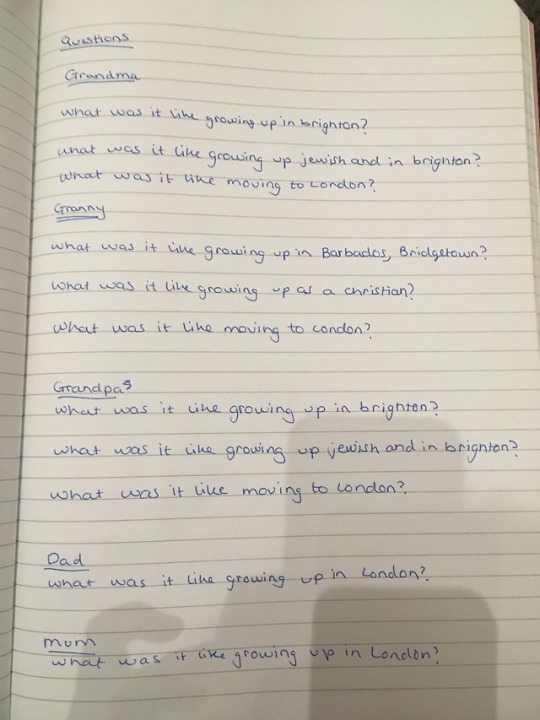
Possible questions to ask my family members. I will need to ensure that their answers are not too long as this may become difficult in learning what they had to say to mouth to.
0 notes
Photo
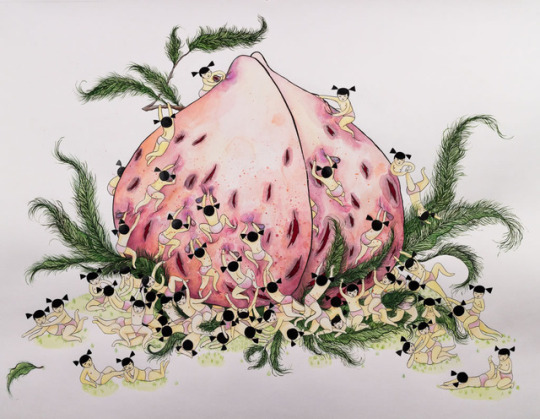
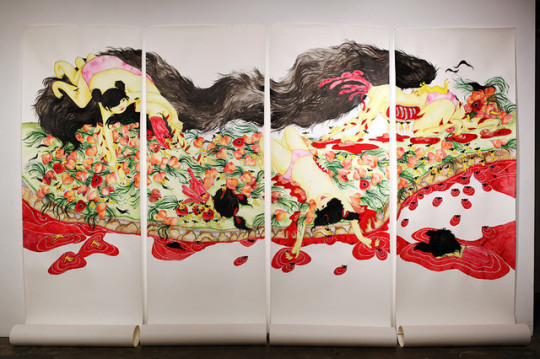
Cathy Lu is an Asian-American artist who looks into the ideas of exploring her cultural identity through the use of art. Being a Chinese girl that was born and lived in San Francisco. Even though she can’t speak the language she tries to connect with her family culture by fusing the two cultures she has been nourished in in her paintings and sculptures.
0 notes
Link
Yinka Shonibare
Makes sculptures and clothing out of traditionally seen African patterns however when looking into the past of these patterns they are found to be originally Indonesian and brought to Africa by the dutch and his sculptures often show some sort of colonialist element.
Shonibare says: “What you see is not necessarily what you get” He talks about how you might want to find out more about something before you make assumptions on it.
0 notes
Link
I feel that using this audio technique in my piece will help to show the way in which we are made up of multiple things whether that be culture, race or even personalities they all stem from older and past generations.
It will also help to indicate that the generations before me and my brother are still a part of us a part that makes us up to be whole.
0 notes
Text
Initial Idea
For my piece I have decided to look into the way in which me and my brother are made up of multiple cultures and to interview family members that had different upbringings collating them into most probably one speech. Then taking inspiration from Gillian Wearing’s piece “2 into 1 “ I would like my brother to mouth the words that the male figures in my family say and for me to mouth the words that the female figures in my family say, allowing ourselves to be seen as what we are truly made up of.
I would like to project the piece onto a large paper Machier sculpture of the world and I would like to hang this from the ceiling in the middle of a room. The world is there to symbolise the way in which both me and my brother although having lived in the UK all our lives have relations to multiple countries.The world would be painted black and white to further symbolise the mixed races of both Louis(brother) and I.
As a very light skinned mixed race girl, with braids(faux dreads)I find myself often being looked at, this is not me being a narcissist. Overtime I have realised often the reason people look is because they are trying to work out and place where I come from. Am I white?Am I mixed? Am I hispanic? Recently I was asked whether I was half japanese??? This is a natural human instinct to want to place people in groups as it comes from tribal instinct.Tribes wanting to know who their tribe members are, this is why certain tribes in Africa started to identify by the specific hairstyles they would create for their tribe. I think using this idea may allow an audience to realise that our instinctive placement is no longer useful as now in the modern world pretty much everyone has roots in different countries.
0 notes
